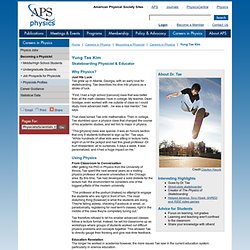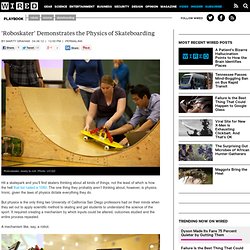

Skate Science Part 2. Skate Science Part 1. Dr. Skateboard's Action Science - Forces. Dr. Skateboard's Action Science - Motion. Dr. Skateboard's Action Science - Simple Machines. The Physics Of Skateboarding With Dr. Tae. Skateboard Science: Skateboarding Physics & Tricks. Physics Of Skateboarding. An understanding of the physics of skateboarding is useful to skateboarders when they do some of their tricks and jumps.

It allows them to identify those key physics principles enabling them to properly execute certain moves, which is useful from a performance point of view. In addition to having an intuitive understanding gained from practice, understanding some of the physics theory behind the tricks and jumps can help make sense of the mechanics involved, which is particularly useful for those who are just starting out. The physics behind several skateboarding tricks will be discussed. Physics Of Skateboarding — The Hippie Jump In the hippie jump, a skateboarder rides along on a flat horizontal surface at a certain velocity Vh.
In this trick the skater must propel himself up by pushing vertically down with his legs. After the skateboarder jumps off the board, gravity takes over and he follows a parabolic arc as he flies through the air (as shown), before landing back on the board. Science of Skateboarding - PHYSICISTS EXPLAIN TRICKY SKATEBOARD PHYSICS. Smec/gk_fellows/Documents/ThePhysicsofSkateboarding.pdf. Dr. Tae- Skateboarding Physicist. Why Physics?

Just His Luck Tae grew up in Atlanta, Georgia, with an early love for skateboarding. Tae describes his dive into physics as a stroke of luck. “First, I had a high school [calculus] class that was better than all the math classes I took in college. My teacher, Dean Goldgar, even worked with me outside of class so I could study more advanced math…he was a real mentor,” Tae says. That class turned Tae onto mathematics. “This [physics] class was special- it was an honors section that only 8 students bothered to sign up for,” Tae says. Using Physics From Classroom to Conversation After getting his PhD in Physics from the University of Illinois, Tae spent the next several years as a visiting physics professor at several universities in the Chicago area.
“The professor at the podium [makes] no attempt to engage the students who are right in front of him. Tae therefore refused to let his smaller advanced classes follow a lecture format. Building a Culture of Teaching and Learning. The Physics of Skateboarding with Dr. Tae. Science of Skateboarding. The Physics of Skateboarding. 'Roboskater' Demonstrates the Physics of Skateboarding.
Roboskater, ready to roll.

Photo: UCSD Hit a skatepark and you’ll find skaters thinking about all kinds of things, not the least of which is how the hell that kid nailed a 1080. The one thing they probably aren’t thinking about, however, is physics. Ironic, given the laws of physics dictate everything they do. But physics is the only thing two University of California San Diego professors had on their minds when they set out to apply scientific method to skating and get students to understand the science of the sport.
A mechanism like, say, a robot. “It’s the scientific method, like what Galileo did when he experimented with acceleration by rolling balls on an incline,” said mechanical engineering professor Nathan Delson. Watching Tom Schaar land the world’s first 1080 — that’s three complete revolutions — or Brandon Westgate do an upstream backside Smith grind will make you think skateboarders defy the laws of physics.
One thing they discovered early on is pumping matters.